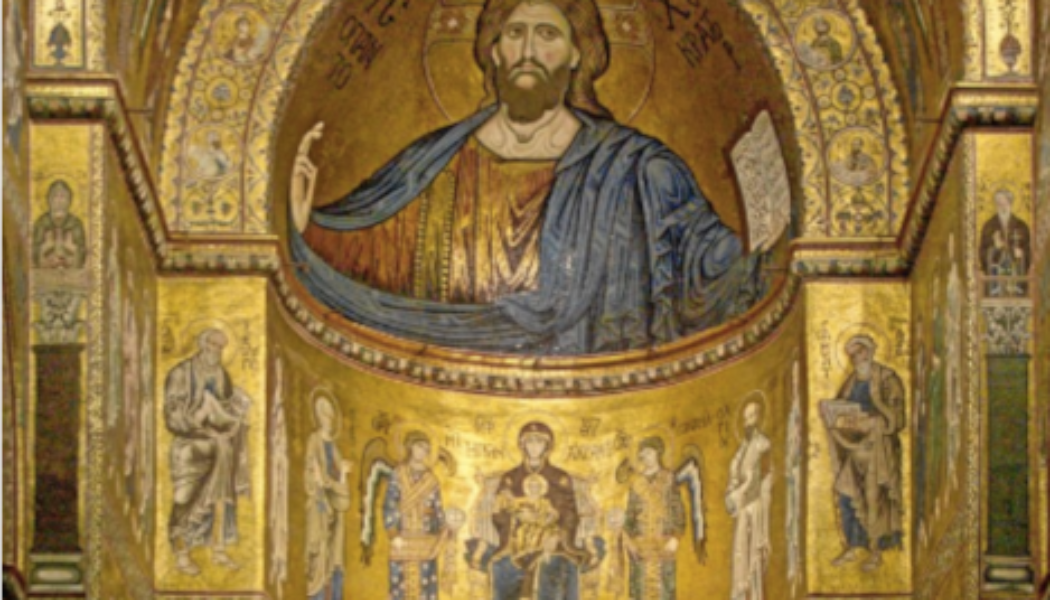Sometime during the 17th century, philosophy held a big rummage sale. “Everything Must Go,” particularly the antiquated and popish.
By Carrie Gress
The art world is often daunting. It can feel esoteric and inaccessible, with the criteria for what is beautiful, popular, and expensive changing quickly according to whim.
Few of us realize that what we think about art is laden with ideas from Descartes, Hobbes, Kant, Marx, Hegel, Nietzsche and so on. By and large, these men have all added to the intellectual soup of our contemporary world. We think their thoughts unthinkingly.

Monreale Cathedral, Siciliy, 12th century. (Wikicommons, Berthold Werner)
The influence of these thinkers goes well beyond art, but art provides a lens to tease out the problems more readily because we intuitively sense the difference between the Pieta and a Picasso. Philosophical ideas can literally be seen in art, whereas in other areas they can feel abstract and foreign.
Two major trends in philosophy, the Enlightenment and Analytic philosophy, have done little to make their work compelling, accessible, and true to the meaning of the word philosophy, that is, lovers of wisdom.
There are several notions populating the way we think about what art is and what it means. Such as:
1) Art is for its own sake. It doesn’t have to “do” anything but exist.
2) Art is about self-expression.
3) It is a separate kind of knowledge. The artist can see things regular folks can’t.
4) It is a kind of escape.
5) It is entirely subjective. Beauty is in the eye of the beholder.
These are some of what we consider the self-evident truths that define contemporary art. But all of these ideas did not come out of thin air. They generally came from one or several Enlightenment philosophers.

Picasso, Woman Sitting Near a Window. Recently sold for $44 million (Wikicommons)
How did this change happen? Well, sometime around the 17th century, Rene Descartes’ concern that very little could actually proven, took root in the minds of philosophers and philosophy reinvented itself. The old ideas and principles, many of which had served for millennia, lost their flavor and it was time to toss them aside.
A big philosophical rummage sale was held. “Everything Must Go.” As the antiquated and popish items were being sold off – anything with a reference to God and those banal Greeks – a few vendors realized that they couldn’t part with one thing. What will we do about beauty? “Oh, I hadn’t thought of that,” gasped Hobbes.
“Yes, but if we keep beauty, we get stuck with the idea that it must do something, that there must be a reason for it, and we certainly can’t have that. Teleology (the technical term for an object’s purpose or goal) is so 16th century,” said Hume.

Willem de Kooning, Art Institute of Chicago (Wikicommons)
Determined to save art and beauty, the philosophers agonized over how to keep it. “What if,” one philosophe suggested, ringing his sweaty hands together, “what if we suggested that art has no purpose, but that art is for…. itself. Wait, that doesn’t make sense,” shaking his head. “What about art for art’s sake? Ah, yes, now we are onto something.”
And so it was – art and beauty were saved from the rummage sale. Relieved that someone found a way to rescue art, a new science was developed: aesthetics.
Well, maybe it didn’t happen exactly like this, but the end result was the same (believe me, the full story makes a great sleep aid). Beauty and art were salvaged without God, purpose, and metaphysics. In their turn, the philosophers added their own touches to aesthetics:
1) Art for its own sake: the Utilitarians
2) Art is about self-expression: Hegel
3) The artist has a separate kind of knowledge: Kant
4) Art is an escape: Schaupenhauer
5) Art is entirely subjective: All of the Above
All of this might seem a bit pedestrian. Of course, this is just what art is today. But what did all of these ideas supplant? What did we lose in the exchange? What was sold off in that grand intellectual rummage sale?
What was truly lost were several ideas held by the Greeks, the early Church Fathers, such as St. Augustine, and the medieval Scholastics. Among them:
1) Beauty is a reflection of God.
2) Beauty is in the eye of beholder, but also in the object. Both are necessary.
3) Order, symmetry, clarity, and light contribute to making something beautiful.
4) An artist must be trained.
5) The artist serves the people by putting onto canvas, or glass, and so on, the Christian story (particularly for the illiterate).
6) Beauty lifts the soul, lifts up our hearts to God. It is a window into heaven.
All of this, literally, comes into focus when medieval art is compared with modern art. As Chesterton said, “Art in the middle ages was ‘art for God’s sake’; art in the Renaissance was ‘art for man’s sake’; art in the 19th century was ‘art for art’s sake’; now art in the 20th century is ‘no art, for God’s sake.’”

Michelangelo, Madonna with Child, Brügge, Belgium (Wikicommons, Elke Wetzig)









